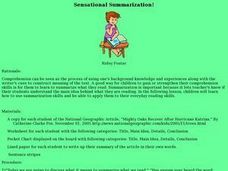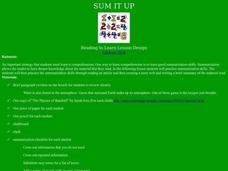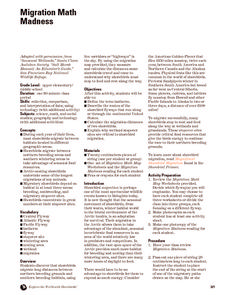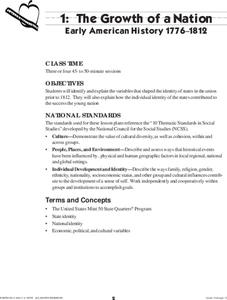Curated OER
Some Simple Rules to Sum it Up!
Students observe and demonstrate three steps to summarize text. They read and discuss the three steps to summarizing, then silently read an article about dugongs from "National Geographic Kids" magazine. Students demonstrate the three...
NASA
Geographical Influences
"If global warming is real, why is it so cold?" Distinguishing the difference between weather and climate is important when it comes to understanding our planet. In these activities, young scientists look at the climate patterns in a...
Curated OER
The Great Koala Rescue
Third graders examine an animal rescue that occurred in Australia by reading an article from National Geographic Kids Online. Individuals practice their non-fiction reading skills and are introduced to new terms as they investigate the...
Curated OER
Oh, the Regions
Focus on the geography of Oklahoma. In this activity, learners compare different geographic regions in Oklahoma, create a collage to share their results, and identify important landforms throughout the United States, such as the Rocky...
Curated OER
Let's Get the Facts!
Students observe and demonstrate the process of summarization. They discuss the three steps of summarization, then silently read a National Geographic Kids News article. As a class they complete a semantic map of the article, and write...
Curated OER
What Was That All About?
Through direct instruction, the teacher demonstrates how to identify the main idea and supporting details of a text when creating a summary. As a class, read a paragraph, highlighting relevant information and crossing out extraneous...
Curated OER
As the Kids Come and Go: Mapping a Classroom
Map the classroom with your kids to help them understand how maps work and how to read them. The lesson starts off with a story about animals living and moving around the globe, and then kids create maps of their classroom to show how...
Channel Islands Film
Dark Water: Lesson Plan 2 - Grade 3
A discussion of bioluminescence launches an investigation of animal adaptations. After re-watching the opening minutes of Dark Water, class members listen to a reading of What Do You Do with a Tail Like This, and then create a new animal...
Curated OER
Face to Face Summary!
Young scholars, while in the computer lab visiting the National Geographic Kids website, fill out a checklist of unimportant/redundant information, look for important events and ideas and search for the author's main idea and supporting...
Curated OER
Sensational Summarization!
Students observe and demonstrate a variety of summarization strategies. They silently read an article from National Geographic Kids, and as a class write a summary that includes the main idea and details and the five W's. Students then...
Curated OER
Sum It Up
After a review of the steps involved in writing a summary, class members read The Physics of Baseball by Sarah Ives and use a story web to identify the important details to include in their summary. Class members then choose an article...
Prince William Network
Migration Math Madness
A great way to incorporate math into life science, this instructional activity has learners measure migratory routes on a map and calculate the actual distance that shorebirds on the routes would cover. Learners compute the distance...
National Geographic
Australia, Antarctica, and Oceana
Go on a traveling adventure throughout Australia, Oceana, and Antarctica! This textbook excerpt offers a full unit of study that can easily be supplemented by extra projects or research materials. Learners study maps, read about native...
Curated OER
Let's Summarize!
Students, after brainstorming what summarization is, practice the strategy of summarization to help pick out the important parts of text each time they read. They read and summarize the article, "10 Cool Things About Dolphins," from the...
National Geographic
Rivers and the Gabcikovo-Nagymaros Project
Damming rivers has been a case of necessity versus negative environmental impact since the process began. Kids take on the role of a stakeholder in the proposed damming of the Danube River. They begin by reading arguments for and against...
Curated OER
Get to the Point!
Learners discover what summarization is and why it is important. They focus on the five steps used to summarize and observe as the steps are used to summarize the article "Ghost Tigers of the Rain Forest" out of National Geographic Kids...
Curated OER
Summing It All Up
Students read articles and summarize the main points in this instructional activity. Students read a provided article from National Geographic Kids and create a web detailing the main points. They then use a six step process to write a...
Curated OER
Let's Sum It Up!
Students explore the benefits of summarizing and create their own summaries in this lesson. Students read the "Siberian Survivor" article from National Geographic Kids Online. Students then discuss the important facts mentioned in the...
Curated OER
Look Who's Summarizing!
Students summarize an article in this lesson. Students observe the teacher summarizing a short paragraph. They then look at a National Geographic KIDS and read an article. They use a highlighter to highlight important facts to be...
Curated OER
Our States, My State
Here is a very nice lesson on the shape of the United States, and the shapes of the individual states for your young geographers. They utilize worksheets embedded in the plan to color in a variety of states and to become familiar with...
Curated OER
Science is a Wonderland
Students use the scientific method to study Animalia and Plantae Kingdoms. In this science inquiry lesson, students watch a PowerPoint about science process skills. Students complete the National Geographic bottled Eggs-periment or the...
Curated OER
Hometown Travel Journalism
Steinbeck’s witty memoir, “Travels with Charley: In Search of America,” inspires kids to investigate their neighborhoods as local travel journalists.
US Mint
The Growth of a Nation
Young historians explore the identity of the early United States in this four-part instructional activity series. Working in groups of three, students research the political, economic, and cultural atmosphere of each member of the...
Curated OER
Let's Get Ready to Summarize
Students practice a summarizing strategy in this lesson. They are given a copy of a "National Geographic Kids" article and are encouraged to read it silently. They then use the steps provided to write an individual summary of the article.

























